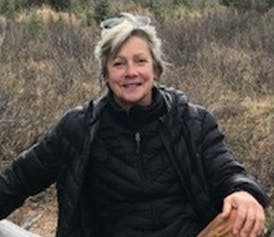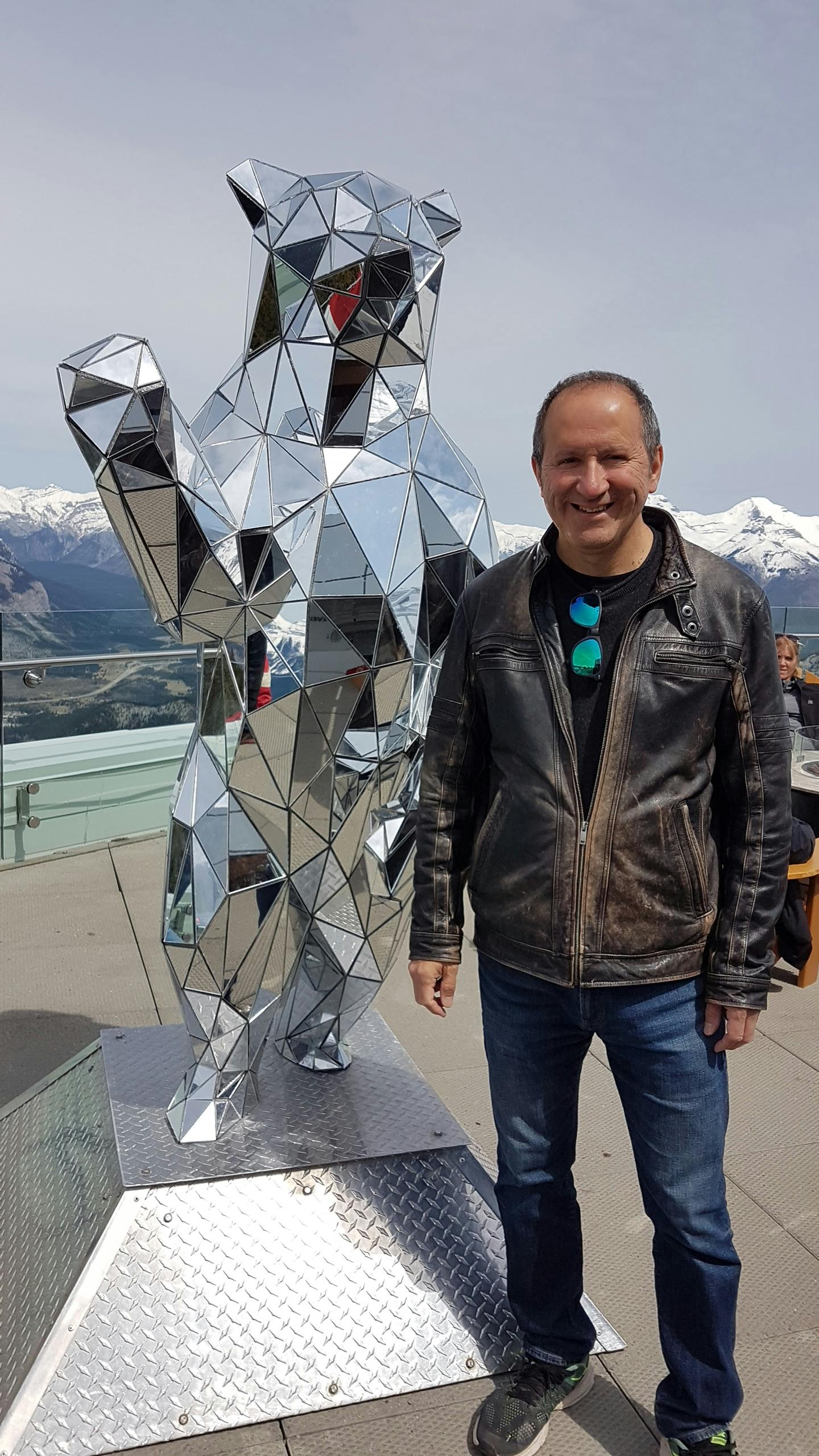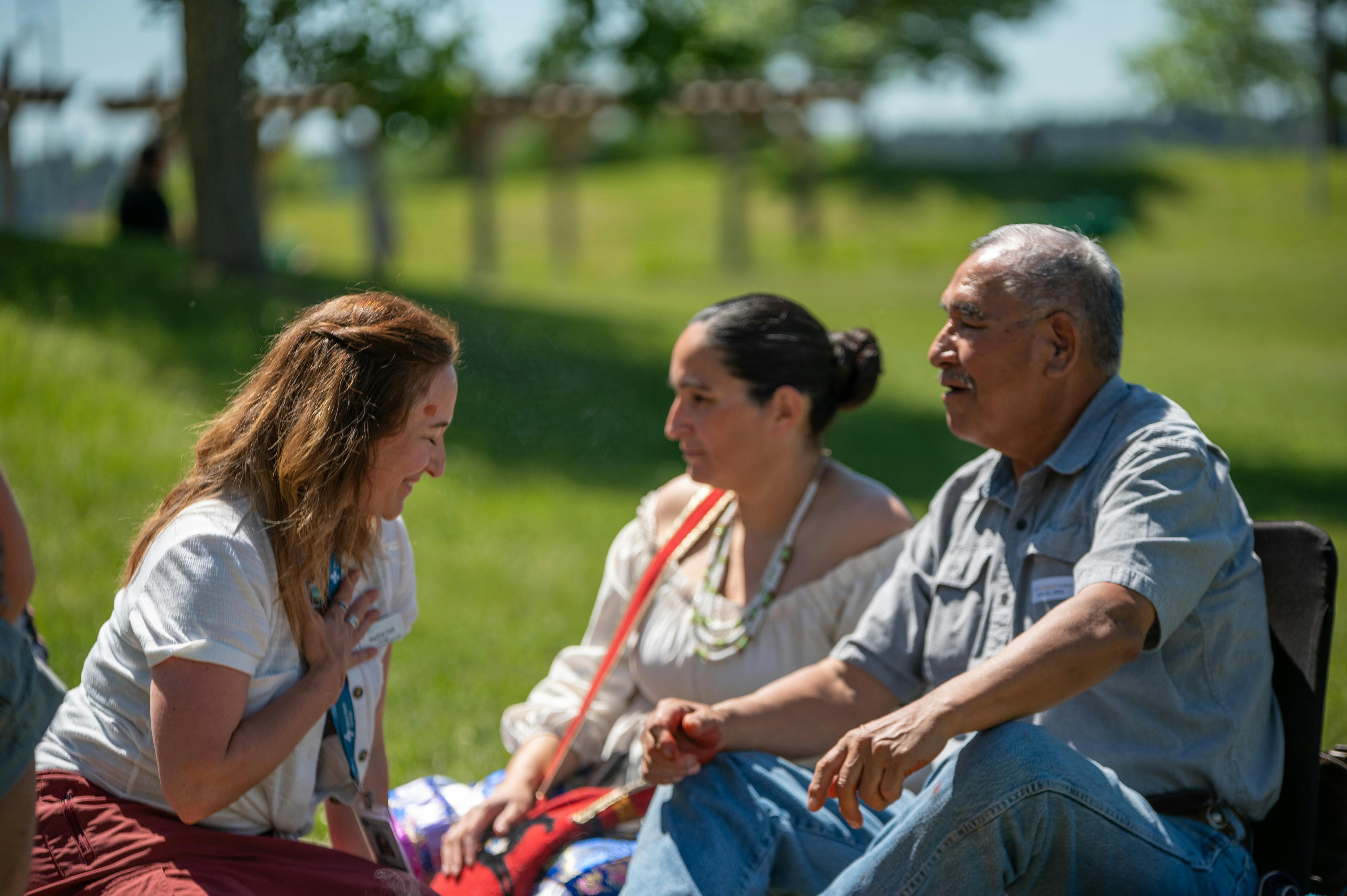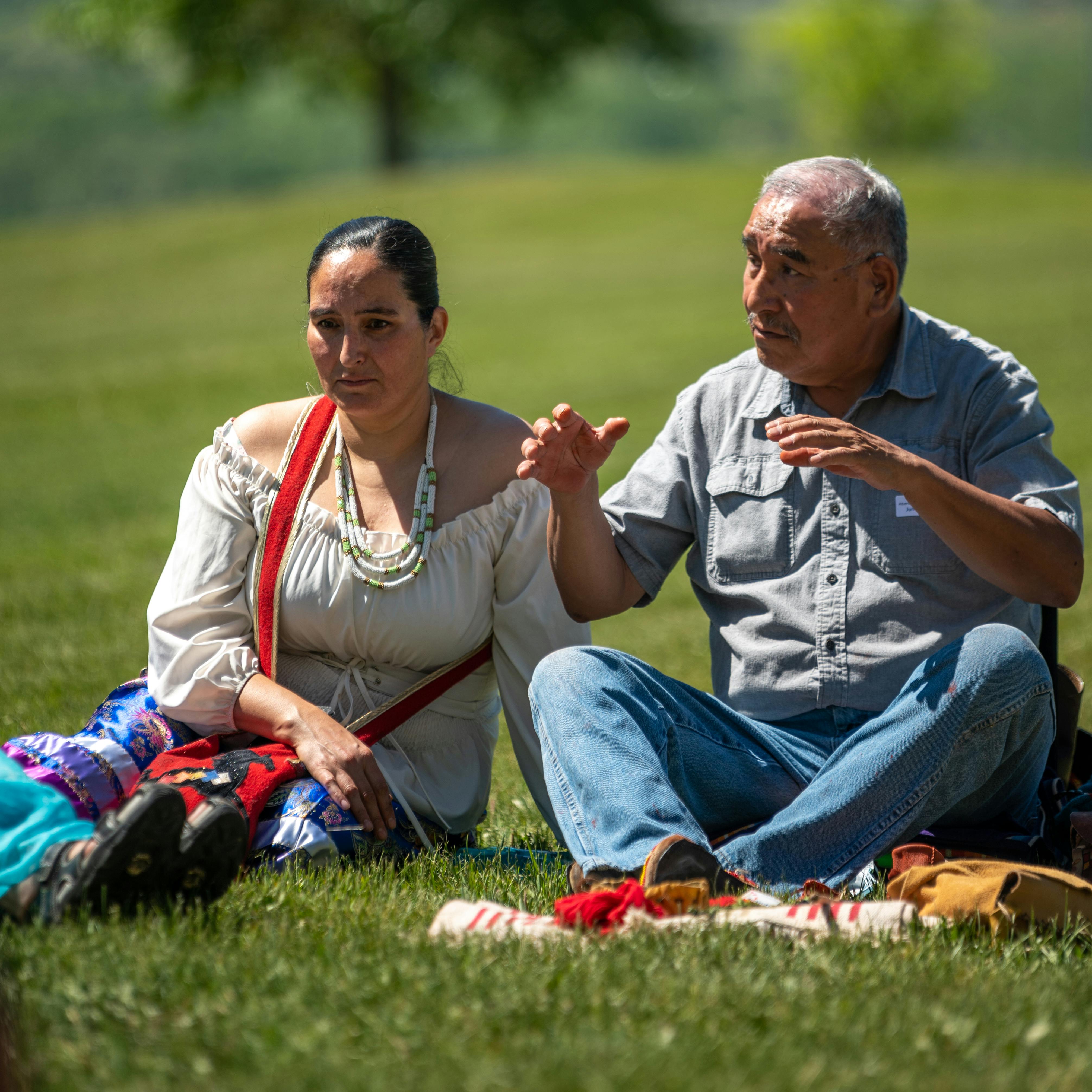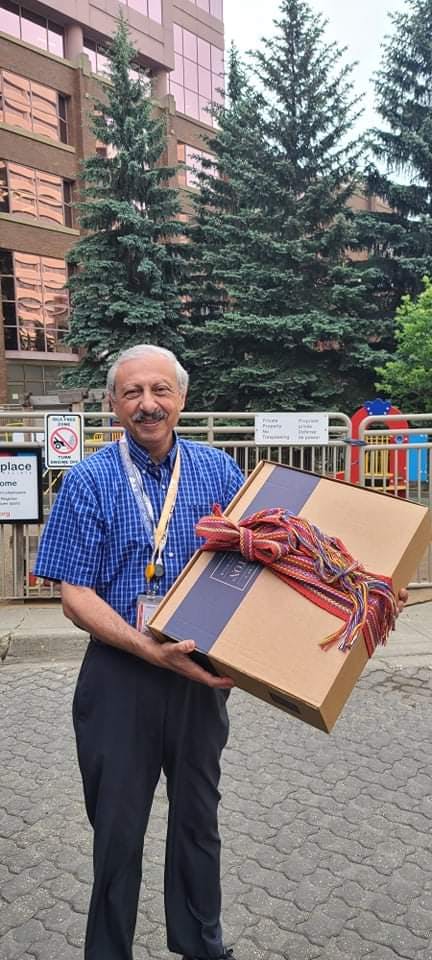2021 National Indigenous Peoples Celebrations
Thank you for joining us to celebrate the 2021 National Indigenous Peoples Day. Visit Alberta Health Services' Indigenous Health Program to learn more.
On June 21, Canada will celebrate National Indigenous Peoples Day. 
First celebrated in 1996, National Indigenous Peoples Day is a day to recognize and celebrate the cultures and contributions of Indigenous Peoples from across Canada.
This year, AHS Celebrated Resilience through Reconciliation by hosting online events throughout the month of June (see all the events here). Thank you to all who took part in the online events.
We encourage you to continue the celebration by sharing your images and stories of strength and resilience. You can also check out the presentations that were given here.
"My mask is called "In Spirit". I have chosen the base color as navy blue with an infinity symbol and beaded Métis flower designs representing Métis peoples. The tulips represent love for all my relations. Focusing on the beauty of nature and in life creates a positive mindset needed to endure our struggles. The mask is surrounded by colors of the medicine wheel in recognition of Indigenous ways of knowing, being and doing.
"This mask is a reminder to return to your spirit, to your culture, your ceremonies, your traditions, your language and your relations to overcome daily challenges. In this way, we may find peace, hope and purpose."
Lisa L'Hirondelle, Métis Cree
On June 21, Canada will celebrate National Indigenous Peoples Day. 
First celebrated in 1996, National Indigenous Peoples Day is a day to recognize and celebrate the cultures and contributions of Indigenous Peoples from across Canada.
This year, AHS Celebrated Resilience through Reconciliation by hosting online events throughout the month of June (see all the events here). Thank you to all who took part in the online events.
We encourage you to continue the celebration by sharing your images and stories of strength and resilience. You can also check out the presentations that were given here.
"My mask is called "In Spirit". I have chosen the base color as navy blue with an infinity symbol and beaded Métis flower designs representing Métis peoples. The tulips represent love for all my relations. Focusing on the beauty of nature and in life creates a positive mindset needed to endure our struggles. The mask is surrounded by colors of the medicine wheel in recognition of Indigenous ways of knowing, being and doing.
"This mask is a reminder to return to your spirit, to your culture, your ceremonies, your traditions, your language and your relations to overcome daily challenges. In this way, we may find peace, hope and purpose."
Lisa L'Hirondelle, Métis Cree
Thank you for joining us to celebrate the 2021 National Indigenous Peoples Day. Visit Alberta Health Services' Indigenous Health Program to learn more.
Do you have a question about Indigenous Health and History? This is a safe space to ask your questions.
Learn more about Indigenous Peoples and Communities in Alberta.

-
Share Hi, thank you for this important information sharing about First People of Canada. Is there a workshop or Elder of Squamish Nation that teaches about their ways of cultivating, protecting and tending to native plants and ecology located in BC? on Facebook Share Hi, thank you for this important information sharing about First People of Canada. Is there a workshop or Elder of Squamish Nation that teaches about their ways of cultivating, protecting and tending to native plants and ecology located in BC? on Twitter Share Hi, thank you for this important information sharing about First People of Canada. Is there a workshop or Elder of Squamish Nation that teaches about their ways of cultivating, protecting and tending to native plants and ecology located in BC? on Linkedin Email Hi, thank you for this important information sharing about First People of Canada. Is there a workshop or Elder of Squamish Nation that teaches about their ways of cultivating, protecting and tending to native plants and ecology located in BC? link
Hi, thank you for this important information sharing about First People of Canada. Is there a workshop or Elder of Squamish Nation that teaches about their ways of cultivating, protecting and tending to native plants and ecology located in BC?
CV asked over 4 years agoThank you for your question, your response is from the Indigenous Cultural Competency Education team.
We encourage you to contact the Squamish Nation directly as they would be better suited to offer you teachings about their land and the ecology in their area. Thank you.
-
Share I would like to add an acknowledgement of Treaty land to my email e-signature in support of Indigenous reconciliation. I do want to be sure this feels respectful, authentic and supportive. Any suggestions as to how this could be phrased, or if this feels appropriate? How can I determine and explore what Treaty land I live or work on? Thank you! on Facebook Share I would like to add an acknowledgement of Treaty land to my email e-signature in support of Indigenous reconciliation. I do want to be sure this feels respectful, authentic and supportive. Any suggestions as to how this could be phrased, or if this feels appropriate? How can I determine and explore what Treaty land I live or work on? Thank you! on Twitter Share I would like to add an acknowledgement of Treaty land to my email e-signature in support of Indigenous reconciliation. I do want to be sure this feels respectful, authentic and supportive. Any suggestions as to how this could be phrased, or if this feels appropriate? How can I determine and explore what Treaty land I live or work on? Thank you! on Linkedin Email I would like to add an acknowledgement of Treaty land to my email e-signature in support of Indigenous reconciliation. I do want to be sure this feels respectful, authentic and supportive. Any suggestions as to how this could be phrased, or if this feels appropriate? How can I determine and explore what Treaty land I live or work on? Thank you! link
I would like to add an acknowledgement of Treaty land to my email e-signature in support of Indigenous reconciliation. I do want to be sure this feels respectful, authentic and supportive. Any suggestions as to how this could be phrased, or if this feels appropriate? How can I determine and explore what Treaty land I live or work on? Thank you!
Kristin G. asked over 4 years agoThanks for your question - AHS' Indigenous Cultural Competency Education shares this response:
Acknowledging traditional territory shows recognition of and respect for Indigenous peoples and is a small part of developing relationships with the First Peoples of Canada. These relationships are key to reconciliation. Acknowledging traditional territory should come from the heart, and should honour Indigenous peoples’ presence in both the past and the present. It should not simply be a “script” read out at the beginning of a meeting. Wherever possible, speak to members of your nearby Indigenous community to learn how they like to be addressed.
When writing a traditional land acknowledgement, be certain the correct Treaty area, First Nation and/or Métis Community is referenced. The link below offers suggestions for each of the areas in Alberta:
To determine the Treaty and Métis lands that you are a part of, check the following map:
First Peoples Map of Alberta: Alberta School Councils' Association
Here is an example of an acknowledgement from an email signature from the Calgary area:
I acknowledge that the land where I live and work is the traditional home and sacred territory of its’ original keepers: the Blackfoot, Stoney, Nakota Sioux, Tsuu‘tina and Métis peoples of southern Alberta. I recognize the irrevocable harms of the past, I advocate for change in the present and I commit to growth through traditional teachings and wisdom in the spirit of Reconciliation and healing for the future.
-
Share What is the significance of the eagle/feather, infinity symbol and the inukshuk? on Facebook Share What is the significance of the eagle/feather, infinity symbol and the inukshuk? on Twitter Share What is the significance of the eagle/feather, infinity symbol and the inukshuk? on Linkedin Email What is the significance of the eagle/feather, infinity symbol and the inukshuk? link
What is the significance of the eagle/feather, infinity symbol and the inukshuk?
Bonnie asked over 4 years agoHi and thank you for your question - here's a response from the AHS Indigenous Cultural Competency Education team:
Eagle Feather:
The Eagle is a reminder of a person's connection the Creator and is respected during sacred ceremonies. To be presented an Eagle Feather is a great honour and is normally given for cultural knowledge, respect and wisdom.Infinity symbol:
The flag was first used by Metis resistance fighters prior to the Battle of Seven Oaks in 1816. It is the oldest Canadian patriotic flag indigenous to Canada. The Union Jack and the Royal Standard of New France bearing the fleur-de-lis are older, but these flags were first flown in Europe. As a symbol of nationhood, the Metis flag predates Canada’s Maple Leaf flag by about 150 years!The flag bears a horizontal figure eight, or infinity symbol. The infinity symbol represents the coming together of two distinct and vibrant cultures, those of European and indigenous North America, to produce a distinctly new culture, the Metis. The flag symbolizes the creation of a new society with roots in both Aboriginal and European cultures and traditions. The sky blue background of the flag emphasizes the infinity symbol and suggests that the Metis people will exist forever.
*From https://easternwoodlandmetisnation.ca/the-metis-flag/Inukshuk:
Varying in shape and size, the inuksuit have ancient roots in Inuit culture. At Inuksuk Point (Enukso Point) on Baffin Island, there are more than 100 inuksuit. The site was designated a National Historic Site of Canada in 1969.These three symbols together represent our Three Indigenous groups of peoples, our First Nations, Metis and Inuit.
-
Share I'd like to take part in workshops and various teachings of Indigenous cultures, such as dance, storytelling, medicinal knowledge, and working with native plants/ecology. I wanted to know if there are opportunities taught by members of these communities. Can you direct me to organizations or groups that offer something along these lines year round? Thank you! on Facebook Share I'd like to take part in workshops and various teachings of Indigenous cultures, such as dance, storytelling, medicinal knowledge, and working with native plants/ecology. I wanted to know if there are opportunities taught by members of these communities. Can you direct me to organizations or groups that offer something along these lines year round? Thank you! on Twitter Share I'd like to take part in workshops and various teachings of Indigenous cultures, such as dance, storytelling, medicinal knowledge, and working with native plants/ecology. I wanted to know if there are opportunities taught by members of these communities. Can you direct me to organizations or groups that offer something along these lines year round? Thank you! on Linkedin Email I'd like to take part in workshops and various teachings of Indigenous cultures, such as dance, storytelling, medicinal knowledge, and working with native plants/ecology. I wanted to know if there are opportunities taught by members of these communities. Can you direct me to organizations or groups that offer something along these lines year round? Thank you! link
I'd like to take part in workshops and various teachings of Indigenous cultures, such as dance, storytelling, medicinal knowledge, and working with native plants/ecology. I wanted to know if there are opportunities taught by members of these communities. Can you direct me to organizations or groups that offer something along these lines year round? Thank you!
Sally asked over 4 years agoThank you for the question! Although with the learning of Indigenous protocols and traditional teachings is best acquired through direct interactions and involvement with knowledge keepers and Elders, this can be challenging to find when you are just starting to build those connections and don’t know where to start. We get asked this question a lot; here is a compilation of well know resources in which you can begin.
https://bentarrow.ca/ Community based not for profit organization in Edmonton that is led by an Indigenous team that provides resources, workshops, training, and events that are open to the public. They offer an Indigenous newcomers to Edmonton connection for families that are interested in connecting with the traditional supports, such as with Elders and ceremony.
https://miskanawah.ca/who-we-are Guided by Indigenous teachings, Miskanawah offers evidence-informed, supportive services to people in the Calgary area as they strengthen their circles of self, family, community, and culture.
https://anfca.com/ Alberta Native Friendships Centres are located across the province. They have a wide variety of community connections to Indigenous resources, workshops, and cultural supports year round. They do offer year round workshops and dance classes that are open to the public; check out the closest one, this page will direct you to the closest one to you in your region of Alberta.
https://calendar.powwows.com/events/categories/pow-wows-in-alberta/?pno=2&nonitro=1 Listings of pow wows across Alberta 2021. These are open to everyone; it is a beautiful celebration of culture, dance and drumming. Please reach out to the Provincial Indigenous team for any protocols you may want to learn, or feel free to attend one and take part in the ceremony.
https://alis.alberta.ca/plan-your-career/additional-resources-for-specific-audiences/for-indigenous-peoples/indigenous-organizations/ This online tool connects to organizations across Alberta. Listed are a few of the many resources that you can find on this link:
- https://www.itk.ca/ Inuit Tapiriit Kanatami: The National Representational Organization Protecting and Advancing the Rights and Interests of Inuit in Canada
- https://www2.metisnation.ca/ Métis National Council
- https://albertametis.com/ Métis Nation of Alberta
Again, do not hesitate to reach out to the Indigenous Cultural Competence Team for any further questions you may have!
Hiy Hiy
-
Share Are there Indigenous communities in Alberta that still do not have safe drinking water? If so, what can we do to help? on Facebook Share Are there Indigenous communities in Alberta that still do not have safe drinking water? If so, what can we do to help? on Twitter Share Are there Indigenous communities in Alberta that still do not have safe drinking water? If so, what can we do to help? on Linkedin Email Are there Indigenous communities in Alberta that still do not have safe drinking water? If so, what can we do to help? link
Are there Indigenous communities in Alberta that still do not have safe drinking water? If so, what can we do to help?
Karen asked over 4 years agoThank you for your question. Many First Nations across Canada have had long term boil water advisories, and several are currently on short term boil water advisories. Currently in Alberta, all long term advisories have been lifted. However, there are 4 communities that are on short term advisories.
To learn more about how Indigenous Services Canada is working to end boil water advisories for Indigenous communities, click here. You can also can also check out the Alberta Emergency Management website for more information. We’d encourage you to keep an eye out for supports that are advertised on either site.
If you have concerns or would like to learn more, you can reach out to fnihb_drinkingwater.dgspni_eaupotable@hc-sc.gc.ca.
-
Share I want to be respectful when I attend Indigenous events. How do I know what I can and can’t do? on Facebook Share I want to be respectful when I attend Indigenous events. How do I know what I can and can’t do? on Twitter Share I want to be respectful when I attend Indigenous events. How do I know what I can and can’t do? on Linkedin Email I want to be respectful when I attend Indigenous events. How do I know what I can and can’t do? link
I want to be respectful when I attend Indigenous events. How do I know what I can and can’t do?
over 4 years agoThank you for your question. Here's a response from the Indigenous Culutral Competency Education team:
Attending an Indigenous event is a great opportunity to build relationships and to gain exposure to stories and cultural practices that might be different from your own. Many Indigenous events offer the opportunity to:
- Meet local Indigenous people
- Learn about Indigenous culture and history
- Show support for Indigenous communities by taking interest in issues that are important to Indigenous people
Tips for attending events
- Listen and observe. Be open to hearing about other ways of experiencing the world.
- Take your lead from others in attendance. Participate as you feel comfortable.
- Make connections with other people attending. Ask questions about ways you might get involved in further activities of interest.
-
Share What some ways as non-Indigenous allies we can recognize Indigenous Peoples Awareness and celebrations in our workplaces? on Facebook Share What some ways as non-Indigenous allies we can recognize Indigenous Peoples Awareness and celebrations in our workplaces? on Twitter Share What some ways as non-Indigenous allies we can recognize Indigenous Peoples Awareness and celebrations in our workplaces? on Linkedin Email What some ways as non-Indigenous allies we can recognize Indigenous Peoples Awareness and celebrations in our workplaces? link
What some ways as non-Indigenous allies we can recognize Indigenous Peoples Awareness and celebrations in our workplaces?
NY asked over 4 years agoThank you for your question. The Indigenous Cultural Competency Education provided this response:
Allies should be arming themselves with knowledge and sharing that knowledge with others, to breakdown discrimination and stereotypes that some carry with them. Take an Indigenous Awareness course, and always look for ways to learn more about Indigenous Peoples, our culture and values. Follow Indigenous content on social media, and share events with your team. Find out about the Indigenous month celebrations and share with others. Recommend and share your favorite Indigenous Authors, books, movies etc.
-
Share Smudging looks cool – what’s that all about? on Facebook Share Smudging looks cool – what’s that all about? on Twitter Share Smudging looks cool – what’s that all about? on Linkedin Email Smudging looks cool – what’s that all about? link
Smudging looks cool – what’s that all about?
over 4 years agoThank you for your question. Here is the response from the Indigenous Cultural Competency Team:
Smudging is an important custom and tradition of Indigenous people, as this ceremony is used to purify the mind, body and spirit. This tradition can be done whenever an individual is needing to remove any negative thoughts, feelings, and to bring a sense of balance and wellness to the person, or to the environment. Usually the smudge ceremony is done prior to another ceremony, such as a pipe or sweatlodge ceremony. Having an individual smudge before taking part in a ceremony or before they touch traditional objects ensures that the person is free from any negativity and is prepared mentally, physically, emotionally, and spiritually balanced.
The act of smudging involves the use of traditional plants and medicines, which could vary depending on their own familial teachings, or even where they are located across the province. Some of these plants used are cedar, sage, sweetgrass, tobacco, and fungus. During a smudge ceremony, an individual will take one (or more) of the plants and light them with matches. The individual will then use their hands, or a feather to waft the smoke that rises from the plants, around their body and the area they are in. While a person is smudging the intent is to cleanse oneself with the smoke; bringing positive healing and restoration of harmony. The thoughts, feelings and any negativity is thought to be carried to the Creator, while leaving a person with a cleansed mind, body and spirit.
It is important to understand that these teachings are sacred and are passed down within families and communities and will therefore vary depending on who you are learning these from.
-
Share Why do we use the word “Indigenous” now? on Facebook Share Why do we use the word “Indigenous” now? on Twitter Share Why do we use the word “Indigenous” now? on Linkedin Email Why do we use the word “Indigenous” now? link
Why do we use the word “Indigenous” now?
over 4 years agoThank you for your question. The AHS Indigenous Cultural Competency Education team provided this response:
“Aboriginal” was the term used to refer to the original inhabitants of Canada - First Nations, Métis, and Inuit and was adopted by the Federal government in the 1982 Canadian Constitution. In 2015, Provincial and Federal governments started using the term “Indigenous,”mostly in response to calls coming from within Indigenous communities.
Many Indigenous Peoples did not accept the term “Aboriginal” for a number of reasons. First, it was an externally developed English name created without input from Indigenous groups. Self-chosen names are important because they are tied to a peoples’ identity. The word “Aboriginal” also does not properly describe the group of people it is referring to. If it is broken down into its Latin roots, the “ab” part of “Aboriginal” means “away from” or “not,” so technically the name means “not original” which is opposite to the intended meaning. Finally, “Aboriginal” is used for convenience by Canadians and Canadian institutions as an umbrella term to describe a large group of extremely diverse people from across Canada. In doing this, we tend to ignore the diversity of Indigenous communities and treat Indigenous Peoples as one homogenized group.
The term “Indigenous” is in many ways a more appropriate term to describe Indigenous Peoples world-wide, and has been used by the United Nations for many years. The term ties Indigenous Peoples to rights laid out in the United Nations Declaration on the Rights of Indigenous Peoples (UNDRIP). By recognizing First Nations, Inuit and Métis as Indigenous Peoples, the government is acknowledging their legal right to offer or withhold consent to development, while also fostering the principles of equality, partnership, good faith and mutual respect.
By including “Peoples” after “Indigenous” the term acknowledges that there is more than one group of Indigenous individuals. “Indigenous” comes from the Latin word indigena, which means “sprung from the land; native.” Using the term “Indigenous” therefore links Indigenous Peoples to their land and respects their claims over it.
It is preferable to use the Nation-specific term to refer to Indigenous groups whenever possible, because “Indigenous” is still an umbrella term referring to large groups of people. For example, “the Siksika Nation of the Blackfoot Confederacy.” Always pay attention to what communities are calling themselves – some communities use “Band,” some use “Nation,” and there are some who still use “Indian Band.”
Custom
Who's Listening
Presentations - 2021 National Indigenous Peoples Celebrations
Photos of AHS Events
Cultural Activities
-
 Click here to play video
Travelling Song - One Rattle, One People
"Travelling Song: One Rattle, One People" is a project created by Sherryl Sewepagaham, music therapist with Alberta Health Services' Indigenous Health Program, from an idea of sharing a community rattle to celebrate in song for National Indigenous Peoples Day on June 21, 2020.
"Travelling Song" is a well-known and well-loved community song created by The Aboriginal Women's Voices Group, a collective of Indigenous women singers from Canada and the United States who participated in the 3-week residency program at the Banff Centre for the Arts in 1997.
"Travelling Song" was produced by Russell Wallace from the Lil'wat Nation in BC during the program and Travelling Song can be heard on The Hearts of the Nation CD. The participants in "Travelling Song: One Rattle, One People" are Alberta Health Services staff and community members.
There are many rattle teachings and this rattle represents the coming together of many hearts and voices.
Click here to play video
Travelling Song - One Rattle, One People
"Travelling Song: One Rattle, One People" is a project created by Sherryl Sewepagaham, music therapist with Alberta Health Services' Indigenous Health Program, from an idea of sharing a community rattle to celebrate in song for National Indigenous Peoples Day on June 21, 2020.
"Travelling Song" is a well-known and well-loved community song created by The Aboriginal Women's Voices Group, a collective of Indigenous women singers from Canada and the United States who participated in the 3-week residency program at the Banff Centre for the Arts in 1997.
"Travelling Song" was produced by Russell Wallace from the Lil'wat Nation in BC during the program and Travelling Song can be heard on The Hearts of the Nation CD. The participants in "Travelling Song: One Rattle, One People" are Alberta Health Services staff and community members.
There are many rattle teachings and this rattle represents the coming together of many hearts and voices.
-
 Click here to play video
Beading with Nadine
Nadine teaches how to make a beaded lanyard.
Click here to play video
Beading with Nadine
Nadine teaches how to make a beaded lanyard.
AHS Digital Patient Stories
-
 Click here to play video
Togetherness - Tessy's Story
Tessy began her journey as a “medical mom” at the age of 19.
As her daughter fought through the first years of her life, Tessy began to learn the significance of mental, physical, emotional and spiritual health. When she began attending Traditional Ceremonies, everyone around her started seeing a change.
She developed strength and confidence she needed to have a quality of life she always desired for her family.
Click here to play video
Togetherness - Tessy's Story
Tessy began her journey as a “medical mom” at the age of 19.
As her daughter fought through the first years of her life, Tessy began to learn the significance of mental, physical, emotional and spiritual health. When she began attending Traditional Ceremonies, everyone around her started seeing a change.
She developed strength and confidence she needed to have a quality of life she always desired for her family.
-
 Click here to play video
There is hope - Jeraldine's story
This story was gifted to us by Jeraldine, a woman who has discovered strength and healing by celebrating her Indigenous culture.
Having persevered through dark days, she has entered a new season in her life.
Click here to play video
There is hope - Jeraldine's story
This story was gifted to us by Jeraldine, a woman who has discovered strength and healing by celebrating her Indigenous culture.
Having persevered through dark days, she has entered a new season in her life.



